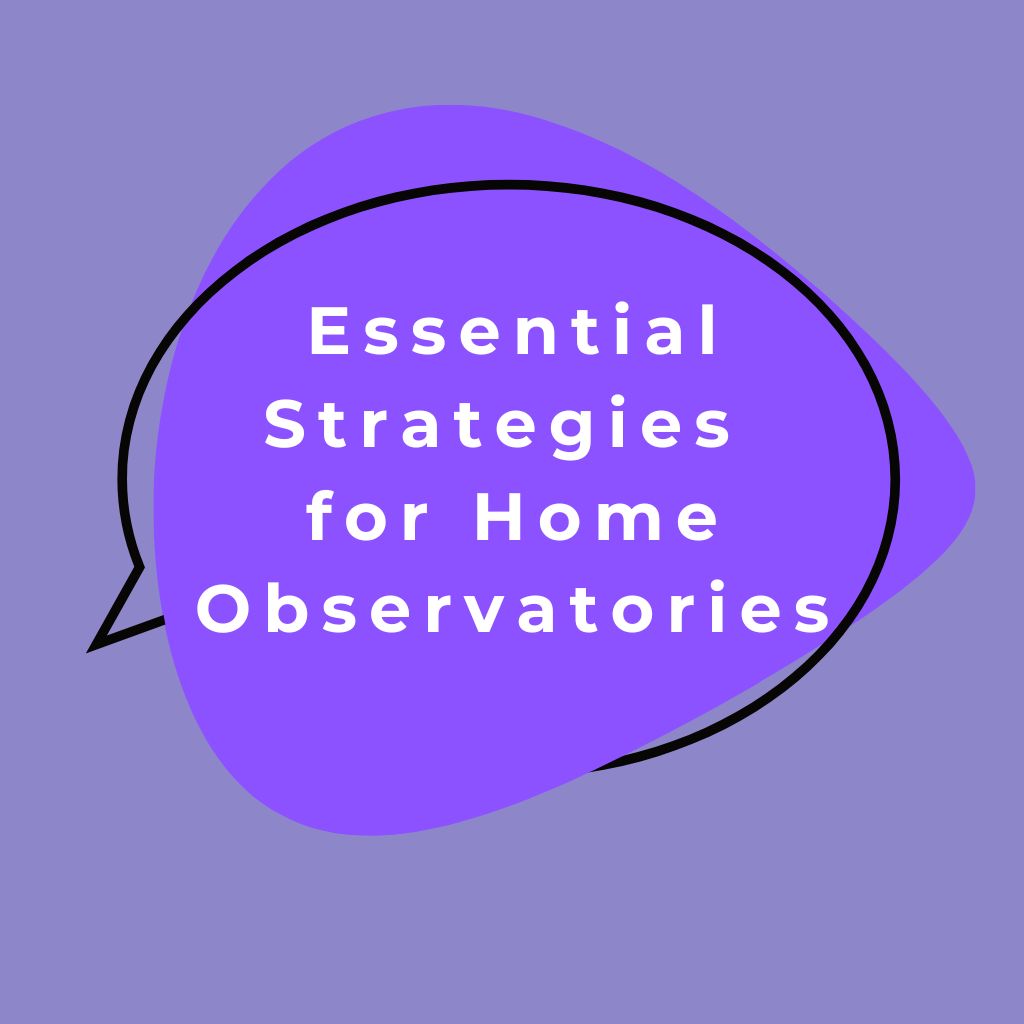This site contains affiliate links to products. I may receive a commission for purchases made through these links.
As an astronomy enthusiast, I’ve spent countless nights gazing up at the stars from my home observatory. But, I’ve found that managing the vast amount of data I collect can be just as complex as understanding the cosmos itself. That’s why I’ve developed effective data management strategies to help streamline the process.
Having a home observatory is a dream come true for many. Yet, it’s not without its challenges. One of the main hurdles is effectively managing and storing the large volumes of data collected. Whether it’s images of distant galaxies or readings from your latest spectral analysis, it’s essential to have a solid data management strategy in place.
In the digital age, data is king. But, managing that data can often feel like a royal pain. With the right strategies, however, you can make your home observatory more efficient and your stargazing experiences more rewarding. Let’s dive into some of these strategies and how they can help you.
The Importance of Data Management for Home Observatories
Let me hit you with a fact: home observatories generate a huge volume of data. Can you imagine trying to find a specific picture or data set in your observatory’s archive without a proper system? It’s like looking for a needle in a haystack! That’s why it’s critical to have an effective data management strategy in place right from the get-go.
Data management plays a vital role in observing celestial bodies. It’s not just about storing data – a robust data management system ensures the integrity and usability of the data. The importance can’t be overstated. It allows quick access to vital information, provides an efficient way to organize and analyze data, and most importantly, prevents data loss.
To bring the point home, consider this: data is the lifeblood of any observatory, home or professional. With a solid data management system in place, you’re in the driver’s seat – ready to harness the power of your data and turn it into meaningful information. Without it, you’re rudderless, wading through a sea of disorganized files and folders.
That’s why a big part of my advice to astronomy enthusiasts building their home observatories revolves around paid or free software for data management. Don’t let the idea of ‘software’ scare you off! Many are user-friendly and offer comprehensive tutorials.
Investing in data management for your home observatory is not only good practice but also a smart move. It saves you time and eliminates the stress of wading through endless files and folders. And with the vast amounts of data your home observatory collects, who doesn’t want that?
With the right strategy, we can all turbocharge our home observatories and take our astronomical observations to the next level. It’s ensuring we don’t just collect data, but use it efficiently too. So, let’s look deeper into how to implement efficient data management strategies for your home observatory – in the upcoming sections of this article.
Understanding the Data Management Challenges
With any scientific endeavor, there comes a complexity of dealing with massive amounts of data, and home observatories are no exception. Data management is crucial, but handling it can often be daunting. Sorting, storing, and most importantly, making sense of data is a herculean task that requires strategic planning and execution.
One of the primary challenges in data management for home observatories is the sheer volume of data. With modern digital imaging technology, a single night’s observation can produce gigabytes of data. And given the scale of sky mappings and imaging, it’s not just about the amount of collected data, but also the speed at which it’s generated.
The next challenge arises in maintaining the integrity of data. Ensuring data’s usability long-term requires stability, redundancy, and rigorous backups. These tasks often demand both significant storage solutions and meticulous attention to detail. Otherwise, you risk losing critical data or it becoming corrupt and inaccessible.
There’s also a challenge in organizing data making it easily retrievable. Your data must be organized in a way that specific information can be found quickly and efficiently. Effective data management involves structuring everything so even older data can be pulled up when needed with minimal time wasted.
Lastly, converting raw data into meaningful information can be challenging. It involves processing and interpreting data, which requires both powerful software and a strong grasp of astronomy. Without an efficient processing system, all your valuable data might as well be gibberish.
Remember, data forms the backbone of your observatory’s operations. Therefore, each of these challenges needs addressing via comprehensive strategies and suitable software solutions. They may seem overwhelming at first, but with an effective plan in place, they’re just hurdles on the way to your personal exploration of the cosmos. Let’s delve into some potential solutions and strategies that can turn these challenges into opportunities for growth in your observatory practice.
Developing a Data Management Plan
Designing an effective plan for data management is crucial for smooth telescope operations. The plan should detail the methods for storing, organizing, and accessing data. It’s important to remember that not all data is equal – valuable data needs to be stored safe and sound while unnecessary data can be eliminated.
The core components of a data management plan include data acquisition, cleaning, organization, storage, and retrieval. Data acquisition is about collecting as much meaningful and accurate observational data as possible. The next step, data cleaning, involves purifying the collected data from noise or errors. Following this, organization and storage let you easily navigate the huge volumes of data. Efficient retrieval of data, the final part of the plan, ensures data’s usability in the long term.
To develop an efficient data management plan for your home observatory, follow these steps:
- Determine your data’s lifespan: Understand and evaluate how long you might need your data. Would it be useful after ten years? Define your storage requirements based on this.
- Classify your data: Not all data carries the same worth. Identify the data that’s valuable and prioritize its storage.
- Outline your primary and backup storage strategies: Data can be lost through technical hitches. Make sure you’ve got a backup plan in place.
- Decide on data formats: Depending on its use, data can be stored in different formats. For example, raw observation data might need to be saved in text files while processed data might be more suitable for a database.
- Draft a detailed documentation strategy: Document every decision made regarding your data. This will come in handy when you need to explain your processes or decisions to others or even yourself in the future.
This strategic approach towards data management can answer complex challenges posed by the vast volumes of data collected in home observatories.
Organizing and Structuring Observational Data
As we delve deeper into our data management plan, an aspect that’s critical yet often overlooked is the organization and structure of observational data. When you’re handling large datasets from your home observatory, it’s not enough to just collect and store data. How you organize your data files and structure your databases significantly influence your ability to access and interpret your data.
Let’s start with file naming conventions. It’s key to use consistent, concise, and descriptive file names. This not only eliminates confusion but also makes it easier to search your files. You may want to consider using a combination of the date, target object, and instrument used for your file names.
Another key component is employing suitable database management systems (DBMS). Without a proper DBMS, managing large volumes of complex data can be overwhelmingly stressful. A well-defined DBMS, be it relational or non-relational, will contribute immensely to your data management workflow.
So, what benefits do you get from organizing your data?
- Streamlined data management process
- Reduced risk of data loss
- Enhanced data accessibility
- Improved data quality
The structure of your data is also critical. Ideally, you would structure your datasets in a way that they mirror your data collection system. This allows for efficient data retrieval and processing. Implementing data models and schemas in your DBMS will also greatly enhance your ability to structure and define your datasets.
At this stage, it’s worth noting that the organization and structuring of data is not a one-size-fits-all solution. You’ll need to adapt your plan to suit the specific needs of your home observatory. With trial and error, you’ll eventually establish a system that streamlines your data management process.
Next, let’s dive into data storage strategies – a critical component of your data management plan. Especially in a world where data is increasingly becoming a valuable asset. It’s crucial to ensure that it is not just stored, but stored securely and effectively.
Using Metadata to Enhance Data Organization
One primary approach to enhancing data organization is with metadata. This can serve as a game-changer when it comes to tackling the overwhelming amount of data generated by home observatories.
Think of metadata as the skeleton that supports the body of observational data. It provides a comprehensive snapshot, clearly showing what data represents by describing each dataset’s specific attributes. I’ve found that correct usage of metadata paves the way for streamlined data management. Plus it reduces the risk of losing data, which any data-heavy operation would appreciate.
Establishing a standard for metadata creation is crucial. Include key information in metadata, such as:
- Time and date of observation
- Instruments used
- Data type (images, readings, measurements, etc.)
- User who collected the data
In some cases, I’ve found it beneficial to incorporate additional data fields into the metadata schema, such as the weather conditions at the time of observation or any anomalies noticed during data collection. These extra details can provide valuable context when revising or analyzing the data later.
Next, let’s talk about assigning descriptive and consistent file names. This might seem like a trivial task, but it’s probably the simplest way to avoid confusion later. It’s true that databases are powerful tools for managing datasets. Yet their value can be significantly compromised if the files they contain are shoddily named. The file name alone should provide someone with a basic understanding of what the file contains.
One quick tip: try to incorporate relevant metadata directly into your file names. For instance, a file name might include the observation date, database type, and a brief descriptor. This strategy not only allows quick identification of files but significantly enhances data accessibility.
Ensuring Data Security and Backup
Just as metadata plays a critical role in organizing and managing data, it’s equally significant to ensure the data’s security and create reliable backup copies. The ethics in astronomy mandate the adoption of astute data security measures. These include encryption, password protection, and access control. Let’s delve deeper into these measures.
Encryption converts understandable data into a code to prevent unauthorized access. It’s a powerful weapon against digital threats, which continue to evolve, causing havoc on personal and professional levels. Mismanaged data can wreak havoc on your home observatory’s functionality and the research you’ve poured hours into.
Password Protection allows only authorized individuals to view the information. Consistently updating and maintaining complex passwords can be an effective barrier against most cyber threats. However, it’s important to manage these passwords effectively. It’d be a shame to lose access to months or years of meticulously collected data simply because a password was forgotten or mishandled.
Access Control is equally vital. Naturally, not everyone should have access to every piece of data. Proper access levels and permissions ensure the data is only visible and editable by those who need it. It also minimizes the risk of data compromise from within.
Let’s explore backup strategies.
Regularly creating Backup Copies of your data safeguards it against harmful events like data corruption or system failures. These disasters can happen without warning so it’s best to have an updated copy of your data on hand. Cloud services, Portable Hard Drives, and Network-Attached Storage (NAS) systems are some of the options for backing up your data.
When it comes to data management, complacency isn’t an option. That said, the combination of effective metadata utilization, stringent data security measures, and dependable backup strategies, can ensure your home observatory functions optimally and your data stays safe and accessible.
Utilizing Data Analysis Tools and Software
In the realm of managing home observatory data, power isn’t just about protection. It’s also about analysis and usability. Effective data management strategies aren’t just limited to the practices discussed above. They extend into the domain of data analysis tools and software, which can turn raw data into meaningful information.
Data analysis tools are your allies in dealing with complex data sets. They enable you to extract, transform, and load your data – commonly known as the ETL process. This not only includes sorting and cataloging your data but also summarizing data findings in a user-friendly format. Picture this: You’ve got heaps of data pouring in from your home observatory, and you need to swiftly sort and analyze it. A powerful data analysis tool comes in real handy here, allowing you to process the information quickly and efficiently.
Different types of data software offer different features. For instance, some provide advanced analytical capabilities like trend identification and forecast prediction, while others are much simpler, primarily focusing on sorting and organizing data. You can choose a tool that aligns with your requirements. Here’s a quick look at some of the most popular tools in the market:
- Tableau: Known for its fast analysis and visualization capabilities
- Excel: The good old spreadsheet software that excels in data manipulation
- Google Analytics: Free tool for analyzing website traffic data
- Python: A powerful programming language for big data
The right combination of these tools can increase the efficiency of your home observatory, making it easier to analyze data and draw valuable insights. But remember, tools can only facilitate the process; it’s your strategy that dictates whether the outcome is a success. With smart data management, well-chosen data tools and software, and a good sense of your required outcomes, you’re well on your way to optimizing your home observatory to its fullest potential.
Collaborating and Sharing Data
When we delve into the realm of astronomy, it’s quite evident that collaboration and data sharing are crucial for progressing our understanding and appreciation of the cosmos. It’s no different for home observatories. Here, data management strategies need to incorporate components that facilitate easier data sharing and collaboration with a global community of researchers, enthusiasts, and professionals.
The first step toward this is employing universal data classifications. Implementing a universal classification scheme for your astronomical data ensures that it can be seamlessly understood, accessed, and utilized by others worldwide. A widely used standardization, the Flexible Image Transport System or FITS, is worth considering.
Next, data sharing platforms come into play. There are several data sharing platforms specifically designed for astronomical data, with a variety of tools that aid efficient data sharing and collaboration. These platforms not just pool a wealth of astronomical data but also facilitate data analysis, interpretation, and visualization by multiple users. Sites like the International Virtual Observatory Alliance and The Zooniverse are standout examples of such platforms.
Let’s not overlook the role of social media either. Social media platforms, while not traditionally associated with data management, can prove instrumental in creating communities, fostering discussions, and sharing findings. Facebook groups and Twitter chats are just a couple of the many ways social media can be utilized to spread the word about your data, findings, or simply connect with like-minded individuals.
Data repository services also highlight the aspect of data preservation. These services, both cloud-based and physical, allow you to store, manage, and share large volumes of data. Through a data repository service, one can maintain data integrity while enabling data access to pertinent individuals.
Collaboration and data sharing are intrinsic elements of astronomical research, even at home-based observatories. With an effective data management strategy woven around these elements, you’re empowered to contribute to the global astronomical discourse more effectively and efficiently. The unending quest for greater knowledge and discovery within the stars continues, and it’s this collective effort that drives us further.
Conclusion
It’s clear that handling data in home observatories isn’t a walk in the park. But with the right strategies, it’s a manageable task. Prioritizing data security and backup is a must. Leveraging data analysis tools can streamline the process, making it more efficient. Collaboration and data sharing have emerged as vital aspects too.
They’re not just about contributing to the global astronomical discourse, but also about learning and growing. Utilizing universal data classifications, data sharing platforms, social media, and data repository services can make this easier. So, let’s embrace these strategies and make our home observatories more productive and contributive. After all, it’s all about exploring the universe from our backyard, isn’t it?









